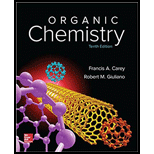
Interpretation:
The splitting pattern for the expected proton in each of the given molecule is to be described.
Concept introduction:
The
The resonating frequency of a nucleus expressed with respect to the standard compound in a magnetic field which is defined to be at
The chemical shift value of the non-equivalent protons is different.
The nonequivalent vicinal protons split the signal of each other, which is called spin-spin coupling.
The multiplicity of signal splitting in
Here
Multiplicity determines the number of neighboring nonequivalent protons.
Want to see the full answer?
Check out a sample textbook solution
Chapter 14 Solutions
ORGANIC CHEMISTRY-W/STUD.SOLN.MAN.
- Which of (a)-(d) indicates the multiplicities for hydrogens on C1, C3, and C4 of butanone attributable to spin-spin coupling in its 1H-NMR spectrum.arrow_forwardWrite notes on the most important absorptions and fragmentations found in the following spectra and use the information to suggest the best possible structure. (Molecular formula: C8H1602, M =144)...arrow_forwardWhat are the major IR absorptions in the functional group region for oleic acid, a common unsaturated fatty acid (Section 10.6A)?arrow_forward
- Can you tell the difference between the olefin isomers by calculating the chemical shifts of the 13Cs? Explain.arrow_forwarda. Which of the following information is primarily obtained from nuclear magnetic resonance spectroscopy? b. Which of the following information is primarily obtained from infrared spectroscopy?arrow_forwardIdentify and draw the structure of the important peaks in the MS spectral data of C8H8O2 given below.arrow_forward
- Discuss every labelled peak in the IR spectrum and identify functional group using the provided table 15.2 (Wavenumbers).arrow_forwardIf the bromine atom was replaced with a fluorine atom in 2-bromocyclohexanol, would the E-Z notations differ for the resulting molecule?arrow_forwardAn old bottle was partially labeled _____-trichlorobenzene. Identify the regeant: (a) draw 3 isomers, (b) predict the expected peaks for their 1H NMR spectra, and (c) match the attached spectrum to one of the isomers.arrow_forward
- Sketch the expected appearance of the indicated protons in 1H NMR spectra of the following compounds. Include approximate chemical shifts and coupling constants in your sketch. Also, briefly explain your answer.arrow_forwardHow might you use IR spectroscopy to distinguish between the three isomers but-1-yne, buta-2-yne and buta-1,3-diene? Explain and justify your answer.arrow_forwardAccount for the following observations: (a) The 1H NMR spectrum of cyclohexane shows a single peak at room temperature, but when the temperate is lowered significantly the peak starts to broaden and then separates into two. (b) At room temperature, the 19F NMR spectrum of PF5 shows two lines, and even at the lowest experimentally accessible temperatures the spectrum is substantially unchanged. (c) In the 1H NMR spectrum of a casually prepared sample of ethanol a triplet and a quartet are seen. These multiplets show additional splittings if the sample is prepared with the careful exclusion of water.arrow_forward
 Macroscale and Microscale Organic ExperimentsChemistryISBN:9781305577190Author:Kenneth L. Williamson, Katherine M. MastersPublisher:Brooks Cole
Macroscale and Microscale Organic ExperimentsChemistryISBN:9781305577190Author:Kenneth L. Williamson, Katherine M. MastersPublisher:Brooks Cole

